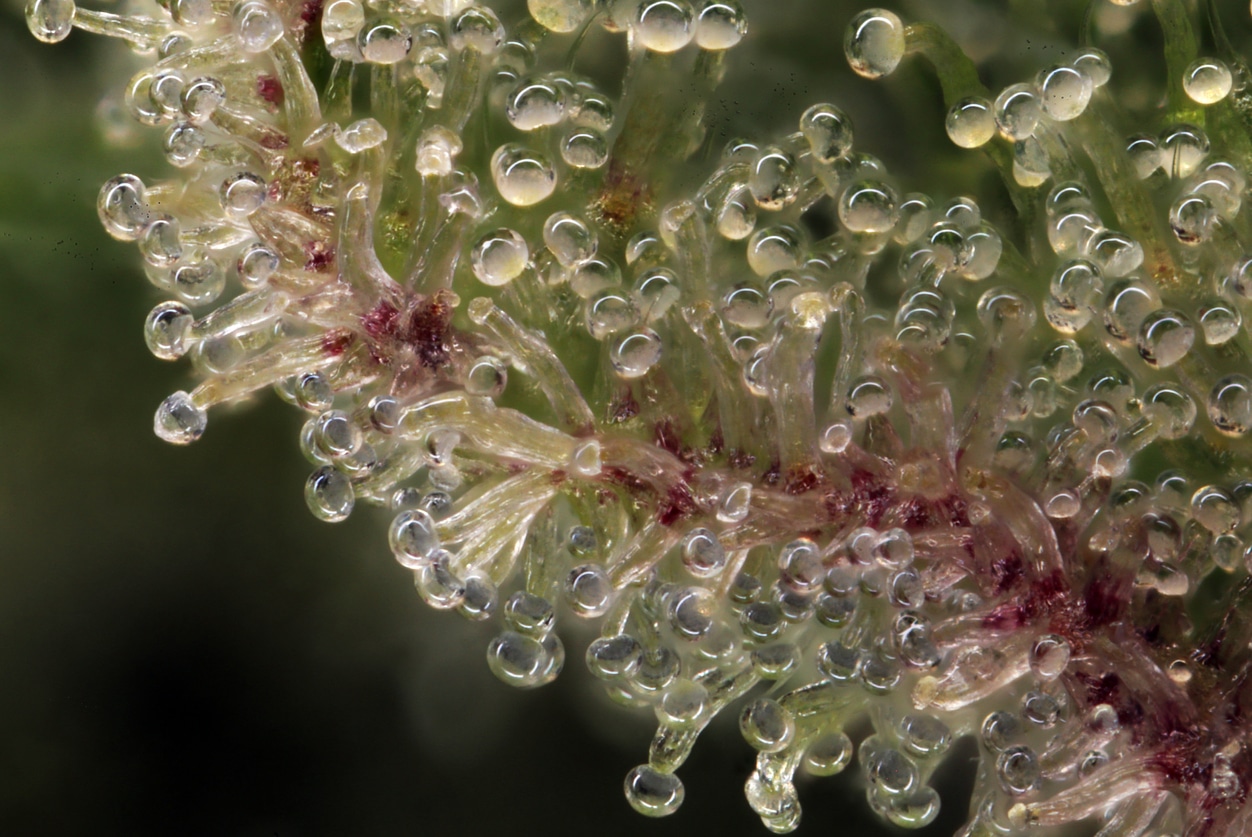In the vibrant world of cannabis, many plant components can impact its effects. Unfortunately, most people only know about the basics, like cannabis strains, cannabinoids, and the amount of THC in what you buy. However, there’s a microscopic element to all cannabis plants that impacts potency and the type of high you experience as well as many other medicinal benefits from the weed. These elements, called trichomes, do a lot for cannabis plants.
What Are Cannabis Trichomes?
Cannabis trichomes are tiny, hair-like structures that develop on the surface of the cannabis plant, specifically on its leaves, flowers and stems. These trichomes are responsible for producing and housing various compounds, including cannabinoids, terpenes, and flavonoids, which are the primary active and aromatic compounds found in the cannabis plant. Trichomes are crucial in the plant’s defense mechanisms, deterring herbivores and pests through producing these potent compounds.
Cannabis trichomes are of particular interest to growers, enthusiasts, and researchers because they contain the compounds that give cannabis its various effects and flavors. When cannabis is harvested and adequately processed, the trichomes can be collected and used to create various products, such as hash, concentrates, oils, and tinctures, which can be consumed for their therapeutic or recreational effects.
Types of Trichomes
When you observe a cannabis plant, the shimmery, crystal-like particles that draw your attention are the trichomes, tiny resin-filled glands. These play an essential role in enhancing potency and flavor within different strains of marijuana. However, there are different types of trichomes types found in cannabis plants. Below are the most common types of trichomes.
Bulbous Trichomes
Bulbous trichomes are among the most miniature varieties, ranging from 10-30 micrometers in diameter. If you’re wondering what trichomes look like at this scale—they’re nearly invisible to the naked eye! These globe-shaped structures develop directly on the surface of all above-ground plant organs. Even though they may lack size, each bulbous hair houses enough cannabinoids and terpenes to have a significant impact on a strain’s effects.
Capitate Sessile Trichomes
Moving up in size brings us to capitate sessile trichomes, approximately 50-100 micrometers wide—still pretty minute but visible under a modest magnifying lens. Resembling small globes perched atop short stalks, these short-stalked structures store more significant amounts of therapeutic compounds than their bulbous counterparts.
Capitate-stalked Trichomes
Next in line are capitate-stalked trichomes—the most recognizable due to their distinctive structure and large size (up to 500 micrometers). Located primarily on female flowers and sugar leaves late into the flowering phase when THC is at its highest concentration level. This type contains high concentrations of active ingredients that give each cannabis variety its unique taste, aroma, and medicinal properties.
Benefits of Cannabis Trichomes
Delving into the benefits of cannabis trichomes will help you understand their crucial role in enhancing the power and effectiveness of marijuana plants. These tiny structures, which some refer to as “trichome crystals,” are notable for their appearance, but their function truly captivates my interest.
First and foremost, cannabis trichomes act as a defense mechanism. Looking at hemp trichomes under a microscope, you’ll notice that they create a protective layer over the plant’s surface. This enables them to deter threats such as insects or damaging UV rays. Essentially, this shield-like characteristic maintains the plant’s health and contributes to its ability to survive harsh environmental conditions.
Secondly, cannabis trichomes are the primary production site for cannabinoids and other biochemical substances found in marijuana plants. Without these microscopic factories at work constantly synthesizing cannabinoids like THC and CBD (which we often turn our focus towards), the medicinal properties we prize so highly would be significantly reduced.
Lastly, it’s worth noting how trichomes impact aroma and flavor profiles within cannabis strains due to terpene production. Terpenes give each strain its unique scent and taste—so those citrusy flavors or pine-like aromas that aficionados appreciate are courtesy of these tiny structures during flowering stages.
Influence of Trichomes on Cannabinoids and Terpenes
The ‘trichome’ definition perfectly fits their function within a cannabis plant. Derived from the Greek word “Tríchōma,” meaning “growth of hair,” these little outgrowths work like micro-factories producing essential compounds for the plant’s survival and consumption.
Interestingly, cannabinoid production occurs mainly in capitate-stalked trichomes, the most prominent trichome types found on mature cannabis flowers. Their heady structure plays host to a fascinating biosynthetic process leading to the formation of various cannabinoids.
Following cannabinoids, terpenes are another treasure harbored by trichomes: volatile compounds responsible for characteristic scents of pine, citrus, berries, or diesel noticeable in different weed plants. These aromatic molecules act synergistically with cannabinoids, enhancing therapeutic effects—an observation called “The Entourage Effect.”
So next time you marvel at shiny hemp trichomes under light, remember—they’re not just surface adornments but vital contributors playing a significant role in sculpting your overall cannabis experience!
Can I Select Cannabis Based on its Trichomes?
Yes, you can use the appearance of trichomes as a factor to help you select cannabis based on its potency and effects. The maturity and appearance of trichomes can give you valuable information about the cannabinoid and terpene content of the cannabis plant, which in turn can influence its effects and overall quality.
The color of the trichomes changes as the plant matures. Early in the plant’s flowering stage, trichomes are often transparent or translucent. As the plant reaches its peak potency, the trichomes become milky white. Later in the flowering stage, some trichomes may turn amber or brown. The ratio of clear, milky, and amber trichomes can indicate the optimal time for harvesting based on your desired effects.
Depending on whether you’re seeking more energizing, uplifting effects, or calming, relaxing effects, you can tailor your selection based on the color and maturity of the trichomes. If you prefer a more cerebral high, you might choose cannabis with predominantly milky trichomes. If you’re looking for a more relaxing experience, you might opt for cannabis with a higher percentage of amber trichomes.
Trichomes also contribute to the aroma and flavor of cannabis. The terpenes contained within the trichomes are responsible for the unique smells and tastes associated with different strains. You can use your sense of smell to gauge the terpene profile of the cannabis and choose strains that have aromas you enjoy.
It’s important to note that while trichome appearance is a useful indicator, it’s not the only factor to consider when selecting cannabis. Factors like strain genetics, growing conditions, and overall quality also play a significant role in the effects and quality of the final product. Consulting with experienced budtenders or growers and reading strain reviews can provide additional insights into the effects and characteristics of different cannabis strains.
When you purchase cannabis from Mountain Annie’s, we’re more than happy to provide you with all the information about the plant’s strain, the cannabinoids and other compounds it contains, and information about where it’s grown. With four convenient locations throughout western Colorado, you can visit us anytime during business hours or visit our website to shop online and pick up inside the store.


